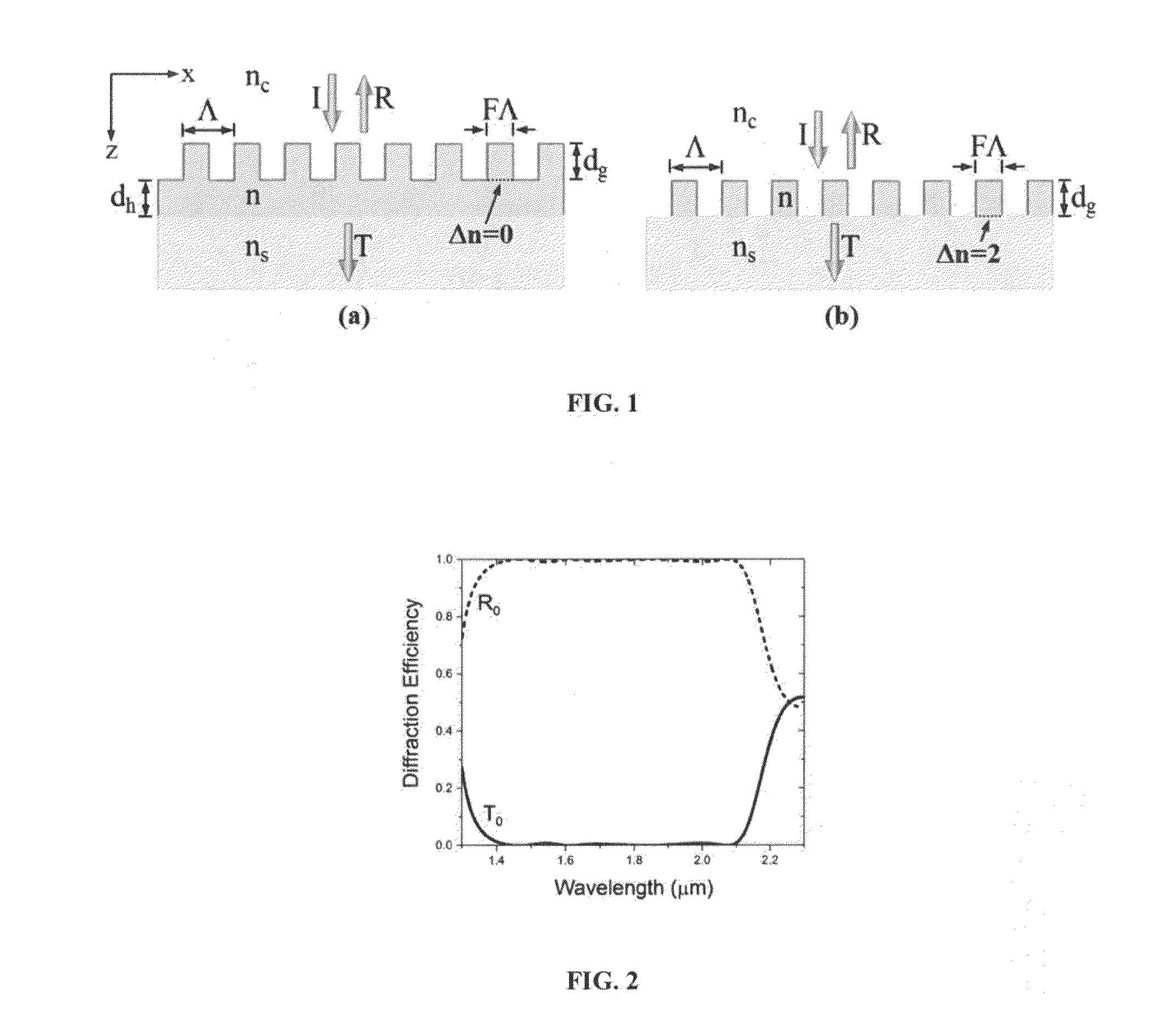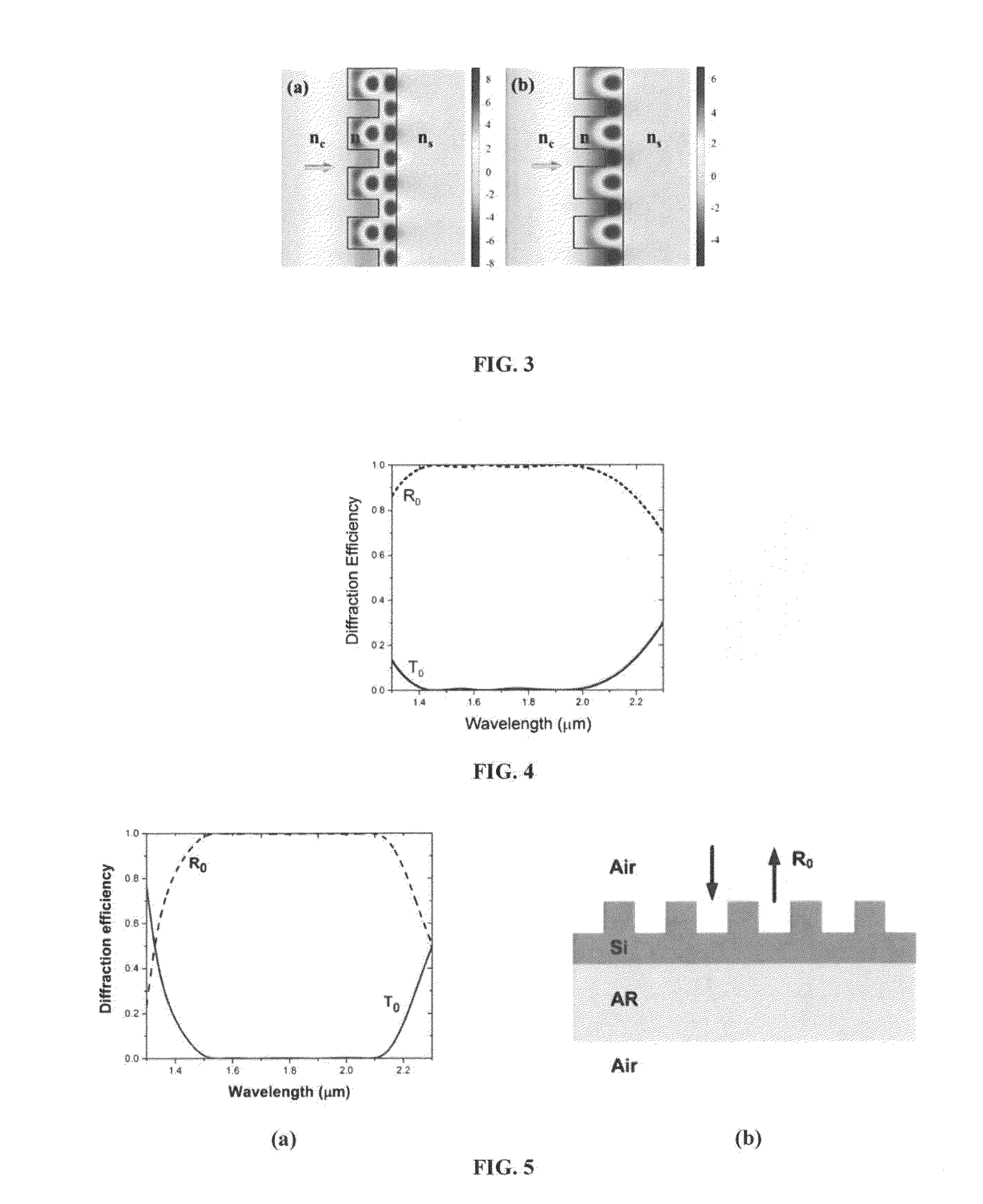Wideband Resonant Reflectors with Zero-Contrast Gratings
a resonant reflector and wideband technology, applied in the field of optical devices, can solve problems such as detrimental sensitivity, and achieve the effects of high yield, high responsiveness to parametric changes, and effective manufacturing
- Summary
- Abstract
- Description
- Claims
- Application Information
AI Technical Summary
Benefits of technology
Problems solved by technology
Method used
Image
Examples
example 1
Zero-Contrast Grating Reflector
[0037]FIG. 1(a) illustrates a generic zero-contrast grating embodiment pertinent to this disclosure, whose distinctive attributes are as described above. As shown therein, the thickness of the grating, layer is denoted by the thickness of the homogeneous sublayer is in the period is A, and the fill factor is F. In particular, the fill factor for a particular period is expressed, as a ratio of the proportion of grating structure relative to the overall period, and may be stated as F, with the measure of filled space in a period represented by FA, as seen in FIG. 1(a). There is a cover material with index of refraction of nc, device material with refractive index n, and a substrate with refractive index ns on which the device of refractive index n is placed. In some embodiments, the period (A) of a reflector device described herein can be sufficiently small such that only the zero-order transmitted (T0) and reflected (R0) waves propagate external to the ...
example 2
Zero-Contrast Grating Reflector with AR Layer
[0038]Assessing the effects of eliminating the z-directed reflection at the ZCG-substrate interface, the substrate in the design in FIG. 2 is replaced with a conventional quarter-wave antireflection (AR) layer centered at 1750 nm, thereby fashioning a membrane in air, FIG. 5(a) shows the resulting zero-order spectra. It is seen that R0>0.99 across a hand exceeding 600 nm in width. FIG. 5(b) shows a schematic of the ZCG membrane with the AR layer attached. The parameter set is dg=490 nm, dh=255 nm, AR layer thickness dAR=235 nm, AR layer refractive index nAR=1.865, A=827 nm, F=0.64, n=3.48, ns=1.48, and nc=1.0. Similar results are-found if a properly designed quarter-wave AR layer is Inserted between the ZCG and the glass substrate in FIG. 2. The conventional single AR layer in FIG. 5(b) can be replaced with improved AR-layer design involving more than one layer.
example 3
Zero-Contrast Grating Reflector with Ultrahigh Reflectance
[0039]For some applications including lasers, it is of interest to increase the reflectance beyond 0.99 to perhaps 0.9999. This can be accomplished within the PSO design strategy by relaxing the spectral bandwidth demand. For example, requiring only 100-nm flat bands for the basic architectures in FIG. 1 yields the results shown in FIG. 6, The ZCG attains R0>0.9999 across 161 nm whereas the HCG only covers 77 nm. The device parameters are as follows: For the ZCG dg=451 nm, dh=623 nm, A=656 nm, and F=0.557; for the HCG dg=490 nm, A=780 nm,and F=0.721. Refractive indices are n=3.48, ns=1.48, and nc=1.0 in both cases, FIG. 7 shows the angular response of these reflectors whose spectra are shown in FIG. 6 at a fixed wavelength of 1550 nm. Both devices provide R0>0.98 out to θ˜10°. Hero 0 is the angle of incidence measured relative to the surface normal of the device, which is the 2-axis in FIG. 1, The ZCG exhibits R0>0.90 for a r...
PUM
 Login to View More
Login to View More Abstract
Description
Claims
Application Information
 Login to View More
Login to View More - R&D
- Intellectual Property
- Life Sciences
- Materials
- Tech Scout
- Unparalleled Data Quality
- Higher Quality Content
- 60% Fewer Hallucinations
Browse by: Latest US Patents, China's latest patents, Technical Efficacy Thesaurus, Application Domain, Technology Topic, Popular Technical Reports.
© 2025 PatSnap. All rights reserved.Legal|Privacy policy|Modern Slavery Act Transparency Statement|Sitemap|About US| Contact US: help@patsnap.com



